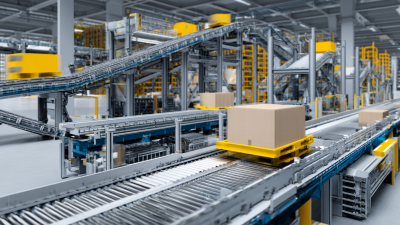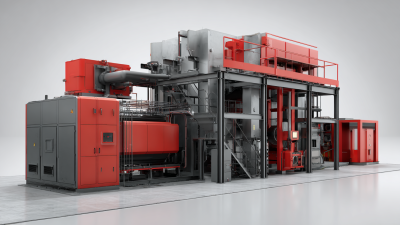 Conveyor technology plays a crucial role in enhancing operational efficiency across various industries, from manufacturing to logistics. As highlighted in the recent report by Grand View Research, the global conveyor systems market is projected to reach $7.16 billion by 2025, exhibiting a compound annual growth rate (CAGR) of 4.6%. This growth underscores the increasing reliance on automated systems to optimize material handling processes. Industry expert Dr. Helen Smith, a leading engineer in automation, emphasizes that
Conveyor technology plays a crucial role in enhancing operational efficiency across various industries, from manufacturing to logistics. As highlighted in the recent report by Grand View Research, the global conveyor systems market is projected to reach $7.16 billion by 2025, exhibiting a compound annual growth rate (CAGR) of 4.6%. This growth underscores the increasing reliance on automated systems to optimize material handling processes. Industry expert Dr. Helen Smith, a leading engineer in automation, emphasizes that
"the integration of conveyor technology not only streamlines production lines but also significantly reduces labor costs and enhances safety standards."
As industries adapt to the demands of modern supply chains, understanding the diverse types of conveyor systems and their specific applications becomes paramount. From belt conveyors used in food processing to roller conveyors for e-commerce, each type offers distinct advantages tailored to meet particular operational needs. This adaptability is a key driver for companies seeking to improve efficiency and reduce operational bottlenecks. Furthermore, the benefits of implementing advanced conveyor systems extend beyond simple transportation; they contribute to greater accuracy in inventory management and reduce downtime, fostering a more productive work environment.
 Conveyor systems are essential components in various industries, streamlining processes and enhancing efficiency. There are several types of conveyor systems, each designed to meet specific needs. For instance, roller conveyors are commonly used for transporting heavy items, while belt conveyors excel in moving light to medium loads over long distances. Additionally, modular conveyors are increasingly popular for their versatility and easy customization.
Conveyor systems are essential components in various industries, streamlining processes and enhancing efficiency. There are several types of conveyor systems, each designed to meet specific needs. For instance, roller conveyors are commonly used for transporting heavy items, while belt conveyors excel in moving light to medium loads over long distances. Additionally, modular conveyors are increasingly popular for their versatility and easy customization.
When selecting a conveyor system, consider the layout of your workspace. Proper planning can maximize efficiency and minimize operational costs. For instance, a curved conveyor can save space and allow for smoother transitions, while an inclined conveyor can efficiently move products between different levels.
Tip: Regular maintenance of your conveyor system can prevent costly downtime. Schedule routine inspections and keep conveyor surfaces clean to ensure optimal performance. Upgrading components like motors or belts can also prolong the life of your conveyor system, ultimately benefiting your operations.
 Conveyor technology plays a crucial role across various industries by enhancing efficiency and productivity. In manufacturing, conveyor systems are integral for moving materials seamlessly along production lines, allowing for the timely assembly of products. For example, automotive plants utilize conveyor belts to transport components from one station to another without manual handling, which minimizes the risk of injury and reduces labor costs.
Conveyor technology plays a crucial role across various industries by enhancing efficiency and productivity. In manufacturing, conveyor systems are integral for moving materials seamlessly along production lines, allowing for the timely assembly of products. For example, automotive plants utilize conveyor belts to transport components from one station to another without manual handling, which minimizes the risk of injury and reduces labor costs.
In the logistics sector, conveyor systems are vital for sorting and distributing packages in warehouses and fulfillment centers. With the rise of e-commerce, companies rely on advanced conveyor technology to streamline operations and ensure timely deliveries. Retail environments also benefit from conveyors, using them to manage stock efficiently and facilitate customer service processes, especially during high-traffic periods. Ultimately, the versatility of conveyor systems makes them indispensable in various fields, contributing significantly to operational efficiency and cost savings.
Conveyor systems play a crucial role in enhancing efficiency and productivity across various industries. According to a report from the International Journal of Engineering and Technology, the implementation of conveyor technology can lead to a productivity increase of up to 30%. This efficiency boost is primarily due to the automation of material handling processes, which reduces manual labor and minimizes the risk of injuries associated with repetitive tasks. As a result, businesses not only save on labor costs but also improve their operational workflow.
In addition to labor savings, conveyor systems are designed to facilitate the seamless movement of goods, thereby reducing downtime. Research by the Material Handling Industry of America indicates that integrating conveyor technology can decrease overall processing times by approximately 25%. This significant reduction allows for quicker turnaround times and improved inventory management, ultimately leading to higher customer satisfaction rates. Furthermore, with the advent of advanced conveyor types such as modular and pallet conveyors, companies can customize their systems to better meet specific operational needs, making conveyor systems an indispensable asset in today's fast-paced industrial landscape.
Innovations in conveyor technology have revolutionized various industries, enhancing efficiency and productivity. One of the prominent trends is the integration of IoT (Internet of Things) capabilities into conveyor systems. This allows for real-time monitoring and predictive maintenance, leading to minimized downtimes and optimized performance. By using sensors and data analytics, companies can track the movement of goods more accurately and adjust operations based on demand patterns, ensuring a more agile supply chain.
Another significant development is the increasing focus on sustainability. Manufacturers are now designing conveyors that utilize energy-efficient motors and environmentally friendly materials. Automation and artificial intelligence are also playing a crucial role in modern conveyor systems, enabling smarter logistics and reducing labor costs. As industries strive to meet sustainability goals, innovations like regenerative drives and modular designs are becoming more prevalent, paving the way for greener and more adaptable conveyor solutions in the future.
| Type of Conveyor | Applications | Benefits | Trends |
|---|---|---|---|
| Belt Conveyor | Material handling in warehouses, airports, and manufacturing | High efficiency, low operating costs, and continuous operation | Integration with automation and smart technologies |
| Roller Conveyor | Sorting and transporting boxes and pallets | Flexible design and easy maintenance | Increased focus on energy efficiency |
| Chain Conveyor | Automotive assembly lines and heavy loads | Durable, capable of handling heavy items | Advancements in materials for longer life |
| Bucket Conveyor | Elevating bulk materials like grains and minerals | Space-saving and suitable for various materials | IoT integration for monitoring and maintenance |
| Magnetic Conveyor | Handling metal materials and parts | Protects against product loss and allows for precise movement | Incorporation of advanced sensor technologies |
When selecting the right conveyor type for your needs, several critical factors must be considered to ensure optimal efficiency and performance. First, evaluate the material you will be transporting. Different conveyors are designed to handle various types of materials, including bulk goods, packages, or even delicate items. Understanding the specific requirements of your materials will help you choose a conveyor that can sustain their weight, size, and shape.
Additionally, consider the layout of your workspace. The available space plays a significant role in deciding on the conveyor system to be used. For tight spaces, modular or flexible conveyor systems may be more suitable, while larger operations might benefit from fixed conveyors. The orientation and flow of materials throughout the facility should also be taken into account to promote smooth operations.
**Tips:** When assessing your needs, always conduct a thorough analysis of both current and future requirements. This foresight can save you from costly adjustments later on. Moreover, consulting with conveyor manufacturers about customization options can lead to a system that fits perfectly into your workflow. Finally, remember to factor in maintenance needs, longevity, and operational costs when making your decision.






